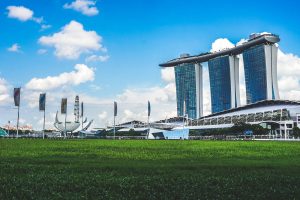
Singapore consistently ranks at the top-end of many cost-of-living surveys internationally. Most recently, Singapore shared top spot as the world’s most expensive city with Zurich in the Economic Intelligence Unit (EIU) Worldwide Cost of Living survey, and ranked second in Mercer’s Cost of Living City Ranking.
While the cost of living is beyond our control, it affects our quality of life in the present, and may impact our ability to save for our retirement in the future.
We look at some of the reasons why Singapore’s cost of living is so high.
#1 Singapore Has No Natural Resources
Growing up, we’ve always learned in our textbooks that Singapore’s only natural resource is our people. This has two implications for Singaporeans, especially with regards to the cost of living.
First, this means we do not have any natural resources to cushion against the impact of higher prices. Other countries with oil and gas reserves for example, can provide subsidised fuel and electricity for its citizens, and those with farmland have more control food prices. Like many other valuable resources, they can also sell excess resources to rake in revenue for the country.
Secondly, not having any natural resources means we are dependent on the world for supplies. For a start, we still rely on Malaysia for over 50% of our water needs.
In turn, this also means we import global inflation, while also being vulnerable to external shocks. During the pandemic, some of our food supplies such as eggs came under pressure. Diversifying our food sources to countries that are further away also increases import costs.
#2 Singapore’s Small Land Size
Singapore’s small size means we not only cannot dedicate much to natural rainforests or agriculture, but also that land is expensive to own. In turn, this has raised housing cost in Singapore.
This is also why we are likely to see Singapore rank highly on global cost of living surveys. They typically take into consideration the costs that a foreign expat may expect to pay, including rents – which is based on property prices.
While Singaporeans do enjoy some buffer with HDB flats, a new 4-room flat in Ang Mo Kio, offered at the October 2024 BTO sales launch, costs between $481,000 to $603,000. Moreover, we have to wait 59 months for construction, as well as be limited its “Plus” project classification.
Looking at a private property can extend our finances even more. For example, based on new condominium prices in 2024, a 3-bedroom, 1,000 sq ft unit can set us back $2.39 million.
Read Also: Is The Condo Dream Getting Increasingly Harder To Achieve For Singaporeans?
#3 Singapore Is A Rich Country
Singapore does not only rank highly in global cost of living surveys, but also wealth surveys. The Allianz Global Wealth Report 2024 puts Singapore at 4th spot globally – stating that Singaporeans have net financial assets worth €172,000.
As a rich country, we can expect to pay more. One of the examples we’ve experienced in the recent past is the World Cup subscription packages. Not only did our northern neighbours get to watch the World Cup 2022 for free, but its broadcaster paid $10 million for the rights to broadcast to a country with a population of over 34 million. In contrast, Singaporeans had to pay $98 to subscribe to the television package, while local networks paid over $25 million for the broadcast rights.
Of course, this is just one example (that the writer still remembers more than 2 years on!).
Next, we also have to take into consideration wage growth – which can have a direct impact on local prices and spending power. In 2024, the Gross Monthly Income From Employment (Including Employer CPF) of Full-Time Employed Residents was $5,500. This is an increase of over 45% increase in the past 10 years.
Looking at this, it should not be surprising that prices should similarly rise by a similar amount.
If we look at the lowest earners (i.e. the bottom 10%) in Singapore, the average monthly household income per household members (including employer CPF) was $706 in 2023. This has risen 52% in the past 10 years – at a slightly faster pace than the median.
#4 Consumption Tax On Certain Goods (Cars, Petrol, “Sin” Products, Luxury Homes)
At the base, there is a 9% GST on goods and services in Singapore. This means everything costs about 9% more expensive than what it should have been.
There are also certain products that have a much higher tax levied on them. For example, all cars in Singapore are subjected to an Additional Registration Fee (ARF), and Excise Duty and GST will also be levied on car prices, and then the sellers have to make a profit. Of course, before we can even buy the car, we need a COE that costs about $100,000 for 10 years.
On top of this, petrol duty and ERP also makes it more expensive to drive cars.
Read Also: Explaining Why Cars In Singapore Are So Expensive
Besides car ownership, certain “sin” products such as alcohol and tobacco is also taxed at a high rate in Singapore – making it expensive to indulge in a night out or have a smoking habit (which is probably for the better).
In Singapore, we also have to pay a Buyer’s Stamp Duty (Different From ABSD), when we buy a property. This is a progressive tax levied on homebuyers and commercial property investors, and increases with the value of the home.
| Purchase Price or Market Value of Property | Buyer’s Stamp Duty (BSD) for Residential Properties | Buyer’s Stamp Duty (BSD) for Non-Residential Properties |
| First $180,000 | 1% | 1% |
| Next $180,000 | 2% | 2% |
| Next $640,000 | 3% | 3% |
| Next $500,000 | 4% | 4% |
| Next $1.5 million | 5% | 5% |
| Amount exceeding $3 million | 6% | 5% |
Read Also: How Much Buyer’s Stamp Duty (BSD) And ABSD Singaporeans, PRs And Foreigners Need To Pay – And When
#5 Ageing Population
As a result of Singapore’s ageing population and enjoying one of the longest life expectancies, there may also be heightened inflation in certain sectors, namely in healthcare and possibly in elder services and even leisure.
With potentially more years in retirement, seniors will likely need more elder care services and engage in senior-friendly leisure activities. These costs are expected to increase as demand goes up.
Already, the government is planning to spend more on healthcare and social and family development. Individuals will also need to plan ahead for such costs.
#6 High Quality Of Living
Singaporeans enjoy a high quality of living – this is everything from well-lit streets, clean and green environment, efficient public transportation, public safety, and everything else. Part of the cost for this is the various taxes that we pay, including personal income tax, which can rise to 24% of our salaries for the highest income earners.
Additionally, as we become accustomed to the high quality of living, many of us may also prefer to upgrade our lifestyles. While this is a good thing for us and our families, it can come at a cost – and constantly comparing to what the “Tan’s” have may not be sustainable.
In short, we should enjoy luxuries, but within our means.
The post Why The Cost Of Living In Singapore Is So High appeared first on DollarsAndSense.sg.









